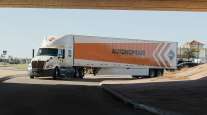Navistar Reports 3Q Loss; New Leaders Outline Plans
By Jonathan S. Reiskin, Associate News Editor
This story appears in the Sept. 10 print edition of Transport Topics.
In their second week in charge, the new management team at Navistar International Corp. reported a quarterly loss for the three months ended July 31 and laid out plans for a return to financial health in the wake of the company’s recent change in its truck engine emissions strategy.
The Lisle, Ill., manufacturer said its adjusted loss was $14 million, or 20 cents a share, on quarterly revenue of $3.32 billion. The adjusted profit in the year-ago quarter was $31 million, or 40 cents a share, on revenue of $3.54 billion.
Beyond the quarterly numbers, Lewis Campbell, new chairman and interim CEO, and Chief Operating Officer Troy Clarke discussed their plans with stock analysts in a Sept. 6 earnings call.
“Look, there is no doubt that we have . . . some really big boulders in the stream,” Campbell said, adding that fixing the problems poses “nothing insurmountable.”
He said that North American trucks, engines and parts are Navistar’s main business and that everything else will be evaluated in terms of return on invested capital to see if it is worth keeping. In addition to the three main components, Navistar has eight major subsidiaries.
Campbell and Clarke succeeded Daniel Ustian, the longtime chairman and CEO, who stepped down and retired on Aug. 27. The company, preparing to switch engine technologies, received word from the Environmental Protection Agency that it can continue selling noncompliant engines by paying financial penalties (see story, p. 1).
Campbell said he has been speaking directly with Cummins Inc. Chairman and CEO Thomas Linebarger about Navistar’s use of Cummins ISX15 engines and exhaust aftertreatment systems.
Navistar will take possession of 300 of the 15-liter engines in November, Campbell said, and have them sold to buyers of International ProStar+ tractors by the end of this year. Navistar also will place the ISX15s in some of its vocational models.
Next April, Campbell said, Navistar will begin selling Maxx-Force-Cummins combinations in International trucks featuring 11- and 13-liter MaxxForce engines and Cummins aftertreatment systems.
Campbell and Clarke said Navistar will use banked emissions credits to satisfy California and the nine other states that follow rules set by the California Air Resources Board. For the trucks sold in the rest of country, Navistar will pay nonconformance penalties, or NCPs, as laid out in the EPA rule.
“We don’t have an infinite number of credits,” Campbell said, adding, “We have plenty of credits for the CARB states.”
Chief Financial Officer Andrew Cederoth said during the call that Navistar paid $10 million in NCPs during the most recent quarter.
Company managers are working on an 18-month operating plan that will be adopted soon, Campbell said, and the benefits of it should become evident in the fiscal year starting Nov. 1.
The transition could be costly, though, as Cederoth said the company will burn through a great deal of money in the current quarter ending Oct. 31, but the company already has financing in place.
Navistar businesses other than North American trucks, engines and parts include Workhorse Chassis, IC Buses, Monaco Recreational Vehicles, Navistar Defense and Navistar Financial. Campbell and Clarke said there is no guarantee that any of them will be sold or closed, but all of them will be evaluated.
Navistar also reported its earnings according to generally accepted accounting principles, or GAAP, but those figures included some substantial one-time charges that made year-over-year comparisons extremely difficult.
Among its major divisions, truck revenue dipped to $2.32 billion from $2.46 billion in last year’s quarter, while the loss narrowed to $30 million from $75 million.
The engine business also had a decline in quarterly revenue to $441 million from $546 million, and last year’s profit of $32 million became a loss of $47 million in the most recent quarter. Internal transfers of engines also declined in value.
The parts division performed the best, posting increases in revenue and profits. Financial services declined in revenue and profits.
The combined operating loss accelerated to $112 million from $63 million.




